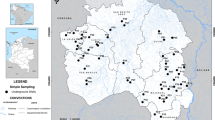Abstract
The Kali-Hindon is a watershed in the most productive central Ganga plain of India. The whole area is a fertile track with sugarcane being the principal crop. Systematic sampling was carried out to assess the source of dissolved ions, impact of sugar factories and the quality of groundwater. Thirty-six samples were collected covering an area of 395 km2. The quality of groundwater is suitable for irrigational purposes but is rich in SO4 which is not best for human consumption. Graphical treatment of major ion chemistry helps identify six chemical types of groundwater. All possible species such as Na–Cl, K–Cl, Na–HCO3, Na–SO4, Ca–HCO3, Mg–HCO3, Ca–SO4 and Mg–SO4 are likely to occur in the groundwater system. The most conspicuous change in chemistry of groundwater is relative enrichment of SO4. The interpretation of data reveals that SO4 has not been acquired through water–rock interaction. The source of SO4 is anthropogenic. Sugar factories alone are responsible for this potential environmental hazard.











Similar content being viewed by others
References
Back W (1966) Hydrochemical facies and groundwater flow pattern in northern part of Atlantic Coastal Plain. US Geological Survey Professional Paper 498A
Bartarya SK (1993) Hydrochemistry and rock weathering in a sub-tropical Lesser Himalayan river basin in Kumaun, India. J Hydrol 146:149–174
Bhatnagar NC, Agashe RM, Mishra AK (1982) Subsurface mapping of aquifer system, water balance study of Upper Yamuna basin. Tech Report No. 2 CGWB N-W Region Chandigarh
Datta PS, Tyagi SK (1996) Major ion chemistry of groundwater Delhi area: chemical weathering processes and groundwater flow regime. J Geol Soc India 47(2):179–188
Drever JI (1982) The geochemistry of natural waters. Prentice-Hall, Englewood Cliffs
Faure G (1998) Principles and applications of geochemistry, 2nd edn. Prentice-Hall, Englewood Cliffs
Khan MMA (2005) Hydrogeology and groundwater quality characteristics of Kali-Hindon sub-basin in parts of western U.P. M.Phil. dissertation, Aligarh Muslim University, Aligarh, 75 pp
Langeier WF, Ludwig HF (1942) Graphic method for indicating the mineral character of natural water. J Am Water Works Assoc 34(3):335–352
Singh IB (2004) Late Quaternary history of the Ganga plain. J Geol Soc India 64:431–454
Stallard RE, Edmond JM (1983) Geochemistry of Amazon River: the influence of the geology and weathering environment on the dissolved load. J Geophys Res 88:9671–9688
Subba Rao N (2001) Geochemistry of groundwater in parts of Guntur district, Andhra Pradesh, India. Environ Geol 41:552–562
Umar R, Absar A (2003) Chemical characteristic of groundwater in parts of the Gambhir river basin, Bharatpur district, Rajasthan, India. Environ Geol 44:535–544
World Health Organization (1993) Guidelines for drinking water quality, 2nd edn, vol 1, WHO, Geneva
Acknowledgement
The authors are grateful to the Chairman of the Department of Geology, A.M.U., for providing facilities to carry out the work.
Author information
Authors and Affiliations
Corresponding author
Rights and permissions
About this article
Cite this article
Umar, R., Khan, M.M.A. & Absar, A. Groundwater hydrochemistry of a sugarcane cultivation belt in parts of Muzaffarnagar district, Uttar Pradesh, India. Environ Geol 49, 999–1008 (2006). https://doi.org/10.1007/s00254-005-0138-4
Received:
Accepted:
Published:
Issue Date:
DOI: https://doi.org/10.1007/s00254-005-0138-4




